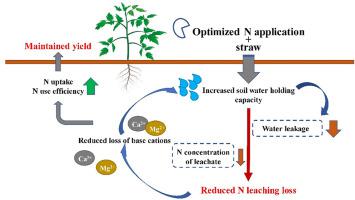Environmental Pollution ( IF 7.6 ) Pub Date : 2022-06-11 , DOI: 10.1016/j.envpol.2022.119616 Weiwei Zhou 1 , Haofeng Lv 1 , Fei Chen 1 , Qunyan Wang 2 , Junliang Li 1 , Qing Chen 3 , Bin Liang 1

|
Excessive fertilization leads to high nitrogen (N) leaching under intensive plastic-shed vegetable production systems, and thereby results in the contaminations of ground or surface water. Therefore, it is urgent to develop cost-effective strategies of nitrogen management to overcome these obstacles. A 15-year experiment in annual double-cropping systems was conducted to explore impacts of N application rate and straw amendment on mineral N leaching loss in plastic-shed greenhouse. The results showed that seasonal mineral N leaching was up to 103.4–603.4 kg N ha−1, accounting for 12%–41% of total N input under conventional N fertilization management. However, optimized N application rates by 47% and straw addition obviously decreased mineral N leaching by 4%–86%, while had no negative impacts on N uptake and tomato yields. These large decreases of N leaching loss were mainly due to the reduced leachate amount and followed by N concentration in leachate, which was supported by improved soil water holding capacity after optimizing N application rates and straw addition. On average, 52% of water leachate and 55% of mineral N leaching simultaneously occurred within 40 days after planting, further indicating the dominant role of water leakage in regulating mineral N leaching loss. Moreover, decreasing mineral N leaching was beneficial for reducing leaching loss of base cations. Therefore, optimized N application rates and straw amendment effectively alleviates mineral N leaching losses mainly by controlling the water leakage without yield loss in plastic-shed greenhouse, making this strategy promising and interesting from environmental and economical viewpoints.
中文翻译:

优化氮肥管理主要通过减少塑料大棚菜地漏水减少矿质氮淋失损失
过度施肥会导致集约化塑料棚蔬菜生产系统下的高氮 (N) 淋溶,从而导致地下水或地表水的污染。因此,迫切需要制定具有成本效益的氮管理策略来克服这些障碍。进行了为期 15 年的一年双熟试验,探讨施氮量和秸秆改良对塑料棚温室矿物氮淋失量的影响。结果表明,季节性矿物N浸出量高达103.4-603.4 kg N ha -1,占常规施氮管理下总氮投入的12%~41%。然而,优化施氮量 47% 和添加秸秆明显降低了矿物氮浸出 4%–86%,而对氮吸收和番茄产量没有负面影响。氮淋失量的大幅下降主要是由于渗滤液量减少,其次是渗滤液中的氮浓度,这得益于优化施氮量和秸秆添加后土壤持水能力的提高。平均而言,52% 的水渗出液和 55% 的矿物 N 浸出在种植后 40 天内同时发生,进一步表明水渗漏在调节矿物 N 浸出损失中的主导作用。此外,减少矿物氮浸出有利于减少碱阳离子的浸出损失。所以,











































 京公网安备 11010802027423号
京公网安备 11010802027423号